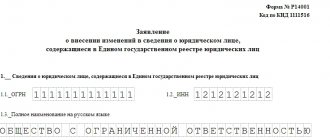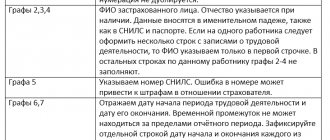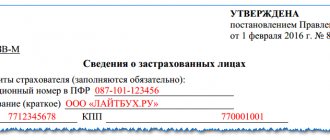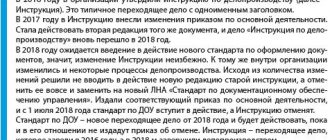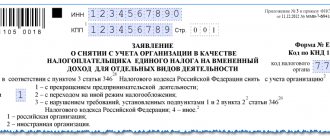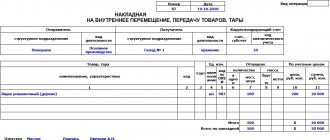Who should submit the 4-OS report?
The report is submitted by all legal entities and individual entrepreneurs, provided that they have fixed assets for environmental purposes and their costs for environmental protection or environmental services amount to more than 100,000 rubles per year. If there are branches and divisions, you must report separately on the parent company and divisions.
To find out whether you must take 4-OS, use the official Rosstat service. It is enough to indicate OKPO, INN or OGRN, and the system will show all the statistical reports that you must submit this year.
If there was no observed event during the year, then reporting does not need to be submitted. There are no “zero” forms for this report.
Legislative framework of the Russian Federation
valid Editorial from 09.08.2012
detailed information
| Name of document | ORDER of Rosstat dated 08/09/2012 N 441 “ON APPROVAL OF STATISTICAL INSTRUMENTS FOR ORGANIZING FEDERAL STATISTICAL OBSERVATION OF AGRICULTURE AND THE NATURAL ENVIRONMENT” |
| Document type | order |
| Receiving authority | Rosstat |
| Document Number | 441 |
| Acceptance date | 09.08.2012 |
| Revision date | 09.08.2012 |
| Date of registration with the Ministry of Justice | 01.01.1970 |
| Status | valid |
| Publication |
|
| Navigator | Notes |
ORDER of Rosstat dated 08/09/2012 N 441 “ON APPROVAL OF STATISTICAL INSTRUMENTS FOR ORGANIZING FEDERAL STATISTICAL OBSERVATION OF AGRICULTURE AND THE NATURAL ENVIRONMENT”
Instructions for filling out form N 4-OS
Legal entities, as well as individuals engaged in business activities without forming a legal entity (hereinafter referred to as individual entrepreneurs), having treatment facilities, carrying out environmental protection measures (independently or in the form of consuming third-party environmental services), as well as making payments for the negative impact on environment, fill out this form and submit it to the territorial body of Rosstat at their location.
If a legal entity has separate divisions, this form is filled out both for each separate division and for a legal entity without these separate divisions.
Information is provided for a legal entity (separate division), individual entrepreneur with an amount of expenses and (or) with a fee for negative impact on the environment of more than 10 thousand rubles. in year.
The completed forms are submitted by the legal entity to the territorial bodies of Rosstat at the location of the corresponding separate division (for a separate division) and at the location of the legal entity (without separate divisions). In the event that a legal entity (its separate division) does not carry out activities at its location, the form is provided at the place where it actually carries out activities. Individual entrepreneurs provide primary statistical data to the territorial bodies of Rosstat at their location.
Bankrupt organizations where bankruptcy administration has been introduced are not exempt from providing information in the specified form. Only after the arbitration court has issued a decision on the completion of bankruptcy proceedings regarding the organization and entry into the unified state register of legal entities of its liquidation (clause 3 of Article 149 of the Federal Law of October 26, 2002 N 127-FZ “On Insolvency (Bankruptcy)”), the organization - the debtor is considered liquidated and is exempt from providing information in the specified form.
The head of a legal entity appoints officials authorized to provide statistical information on behalf of the legal entity.
The address part indicates the full name of the reporting organization in accordance with the constituent documents registered in the prescribed manner, and then the short name in brackets. The form containing information on a separate division of a legal entity indicates the name of the separate division and the legal entity to which it belongs.
In the line “Postal address” the name of the subject of the Russian Federation, legal address with postal code are indicated; if the actual address does not coincide with the legal address, then the actual postal address is also indicated. For separate divisions that do not have a legal address, a postal address with a postal code is indicated.
A legal entity or individual entrepreneur enters the code of the All-Russian Classifier of Enterprises and Organizations (OKPO) in the code part of the form on the basis of the Notification of assignment of the OKPO code sent (issued) to them by the territorial bodies of Rosstat.
For territorially separate subdivisions of a legal entity, an identification number is indicated, which is established by the territorial body of Rosstat at the location of the territorially separate subdivision.
In the code part of the form in column 3, respondents carrying out activities under OKVED codes 01 - 99, with the exception of code 75, as well as the activities of specialized suppliers (code 90), must indicate - 1 (commercial sector).
Respondents carrying out activities under OKVED code 90 must indicate in column 3 - 2 (specialized providers of environmental services).
Respondents who provide specialized environmental services, such as wastewater collection and treatment, solid waste collection and processing, sewage disposal, site cleaning, etc., but these services do not relate to the main economic activity, must prepare two reports, one - for specialized environmental services provided by the enterprise, and the second for other types of economic activities engaged in by the legal entity. For example, legal entities operating under OKVED code 41 submit two reports (one for the main activity, which is included in the commercial sector, the second for activities related to environmental services (wastewater treatment), which is included in the sector of specialized environmental service providers ). Wastewater treatment services should not be included in the core activity report.
Activities and costs shown in this form must be primarily environmental in nature and aimed primarily at environmental protection.
This form does not reflect the activities and costs of their implementation:
— on health protection, improvement of working conditions and safety measures, implemented for technical reasons, but giving a positive environmental effect;
— on the direct use of natural resources (for example, water supply);
— to prevent or combat the consequences of natural disasters and disasters. In particular, activities for forecasting (prevention) and eliminating the consequences of drought, frost, earthquakes, avalanches, landslides, etc. are not included.
In addition, this form does not take into account: mineral extraction tax, water tax, payments for water use under contracts, forest taxes, taxes and fees for the use of biological resources, other similar taxes and payments for the use of natural resources and for the use of natural resources, with the exception of the payments given in section 3 of the form.
The form is filled out based on the primary accounting data of actual environmental protection costs and environmental payments. Data is presented in thousands of rubles.
Section 1. Current costs of environmental protection and revenues (receipts) from the sale of by-products
Section 1 reflects the actual amount of current costs generated in the process of internal production activities and covered by own funds, funds from budgets of all levels and other sources, as well as additional costs and revenues associated with environmental protection.
Current costs are indicated without value added tax.
The amount of current costs for environmental protection includes expenses for carrying out activities, ensuring the ongoing operation of technological processes and production facilities, as well as for the maintenance and operation of machinery and equipment that are designed and operate to prevent, reduce, clean (recycle) and/or eliminate pollutants substances (products) or the contamination itself.
The section reflects data on the following current costs for environmental protection:
— maintenance and operation of fixed assets for environmental protection: raw materials, materials and other products, fuel and electricity used in the operation of environmental funds; costs for routine repairs of these funds, for the maintenance of personnel servicing these funds; rental (leasing) payments, insurance payments relating to environmental structures and equipment (the list of environmental funds is given in Appendix 2);
— costs of collection, storage/disposal and processing/neutralization, destruction, disposal of production and consumption waste on our own;
— organization of independent control over harmful effects on the environment and monitoring activities, scientific and technical research, management of environmental activities in the organization;
— for current measures to preserve and restore the quality of the environment disturbed as a result of previously conducted economic activities;
— other ongoing measures to reduce harmful impacts on the environment.
The section does not reflect data on costs for:
construction of environmental protection facilities,
overhaul of environmental fixed assets,
depreciation charges for fixed assets for environmental purposes,
procurement of environmental services from external organizations (payments to third-party organizations for the reception and treatment of wastewater, as well as for the removal, processing, burial, etc. of production and consumption waste, for the provision of other environmental protection services).
Line 01 shows current (operating) costs in general for all environmental protection measures, which in lines 02 - 10 are distributed according to areas of environmental activities in accordance with the “List of fixed assets for environmental purposes” (Appendix 1) and “List of types of environmental protection activities "(Appendix 2).
Line 02 indicates current costs aimed at protecting atmospheric air and preventing climate change, which are included in current (operating) costs:
— for the maintenance and operation of fixed assets for the protection of atmospheric air and the prevention of climate change,
— to monitor emissions of pollutants into the air (including monitoring compliance with standards for the content of pollutants in exhaust gases from motor vehicles), laboratory research,
— to organize monitoring and control of the quality of atmospheric air,
— modification (improvement) of production processes, transition to other types of fuel, raw materials, materials in order to reduce (eliminate) emissions of pollutants into the air,
— for administration and environmental management, information support, educational activities in the field of air protection and climate change prevention,
— for other ongoing activities in the field of air protection and climate change prevention.
Line 03 includes current costs aimed at collecting and treating wastewater, which are included in current (operating) costs:
— for the maintenance and operation of fixed assets for the collection, transportation, treatment of wastewater, recycling and reuse water supply systems, local treatment facilities,
— to reduce the formation of contaminated wastewater in the production process,
— for reuse of cooling water and purification of cooling water before discharge,
— to monitor the quality of discharged wastewater, laboratory research,
— for administration and environmental management, information support, educational activities on wastewater collection and treatment,
— for other ongoing activities for the collection and treatment of wastewater.
The current costs of wastewater collection and treatment do not include:
costs for the maintenance and operation of industrial and municipal water pipelines, including facilities for the preliminary purification of collected water (water treatment) and its transportation to the consumer,
costs for the maintenance and operation of urban, industrial and other sewer networks that are not connected to treatment facilities and discharge contaminated wastewater directly into natural water bodies.
Line 04 indicates current costs aimed at waste management activities (including processing of low-level radioactive waste, composting, estimates for street cleaning, disposal), which are included in current (operating) costs:
— for the maintenance and operation of fixed assets for environmental protection from production and consumption waste (for collection, separation into types (sorting), placement, neutralization and (or) use of production and consumption waste,
- for activities for the collection, separation by type, storage and transportation of production and consumption waste to specially organized places for their placement, neutralization or use, which are under the jurisdiction of the reporting facility or other organizations (landfills, landfills, waste processing and incineration installations and factories), also to places of their authorized unorganized storage,
— to carry out instrumental measurements and control over the amount and structure of the formation and disposal of production and consumption waste, laboratory research in the field of waste management,
— to determine the physical and chemical composition of waste and (or) to determine the hazard class of waste,
— for administration and environmental management, information support, educational activities in the field of waste management,
— for other ongoing waste management activities.
Line 05 indicates current costs aimed at protecting and rehabilitating lands, surface and ground waters, which are included in current (operating) costs:
— for the maintenance and operation of fixed assets for the protection and rehabilitation of lands, surface and groundwater, including general construction and special equipment,
— for the elimination of landfills, landfills, sedimentation tanks, dumps, “tailings” of enrichment organizations,
— to prevent the infiltration of pollutants into soils, surface and underground water bodies,
— for measures to maintain water protection zones in the established order, to regulate flow and maintain a favorable hydrological regime and sanitary condition of small rivers,
— to clean soils and water bodies from pollution and contamination,
— to prevent erosion and other types of soil degradation,
— to prevent salinization and desalinization of soils,
— for reclamation of disturbed lands,
— instrumental measurements and control, laboratory studies of the qualitative condition of lands, surface and underground water bodies,
— for administration and environmental management, information support, educational activities in the field of protection of lands, surface and underground water bodies,
— for other ongoing activities for the protection and rehabilitation of lands, surface and ground waters.
Line 06 indicates current costs aimed at protecting the environment from noise, vibration and other types of physical impact, which are included in current (operating) costs:
— for the maintenance and operation of fixed assets for environmental protection, prevention and reduction of noise, vibration and other types of physical impact in transport, industrial production and other stationary sources of noise and vibration, for the use of anti-noise and vibration-isolating structures,
— instrumental measurements and control, laboratory studies in the field of noise, vibration and other types of physical impact on the environment,
— for administration and environmental management, information support, educational activities in the field of environmental protection from noise, vibration and other types of physical impact,
- for other current events.
Line 07 includes current costs aimed at preserving biodiversity and protecting natural areas, which are included in current (operating) costs:
— to protect and restore species of animals, plants and fungi and to preserve their habitat (to preserve and restore rare and endangered species, to carry out artificial reproduction of natural populations, to reintroduce (reacclimatize), to prevent the uncontrolled spread of invasive alien species , for the conservation and restoration of rare and endangered species through the use of cryopreservation technologies and the creation of other types of repositories of genetic material to restore extinct populations and species, as well as for maintaining or restoring genetic diversity in heavily disturbed populations, for monitoring, for conducting inventories (accounting), maintaining Red Books, etc.),
— on the conservation and restoration of natural areas,
— instrumental measurements and control, laboratory research in the field of biodiversity conservation and protection of natural areas,
— for administration and environmental management, information support, educational activities in the field of biodiversity conservation and protection of natural areas,
— for other ongoing activities to preserve biodiversity and protect natural areas.
Line 08 indicates current costs aimed at ensuring environmental radiation safety, which are included in current (operating) costs:
— to reduce radiation impact on the environment (to rehabilitate natural areas exposed to radioactive contamination of forests, water bodies, and lands),
— on radioactive waste management (on collection, transportation, processing, storage (localization) of radioactive waste, disposal of radioactive waste),
— instrumental measurements and control, laboratory research in the field of radiation safety,
— for administration and environmental management, information support, educational activities in the field of environmental radiation safety,
— for other ongoing activities in the field of environmental radiation safety.
Current costs aimed at ensuring environmental radiation safety do not include:
costs of preventing and eliminating emergency situations,
costs for collection and processing of low-level radioactive waste.
Line 09 indicates current costs aimed at research and development activities to reduce negative anthropogenic impacts on the environment, which are included in current (operating) costs. They include costs for developments in the field of atmospheric air protection, climate change prevention and ozone layer protection, in the field of wastewater collection and treatment, including the prevention (or treatment) of discharges into surface waters, in the field of waste management, soil protection and rehabilitation, underground and surface waters, environmental protection from noise, vibration and other types of physical impact, conservation of biodiversity and protection of natural areas, etc.
Line 10 indicates current costs for other areas of activity in the field of environmental protection, which are part of current (operating) costs. They include costs for environmental protection and not included in other classes: general administrative and management activities, activities for environmental certification and environmental audit, environmental management and consulting, environmental education and information support in the field of environmental protection, information support for civil society on the state of the environment, on the organization and development of an environmental education system, on the education and formation of an environmental culture, on the education, training and advanced training of specialists in the field of environmental protection, etc. This includes costs that do not fall under other groups of types of environmental activities.
Column 3 reflects information about the actual current (operating) costs for environmental protection incurred during the year.
Column 4 reflects information on current (operating) costs for environmental protection at the expense of enterprises’ own funds.
Column 5 indicates material costs, including costs for the purchase of raw materials and (or) supplies; tools, devices, inventory; components and (or) semi-finished products; fuel, energy of all types necessary for the operation of fixed assets for environmental protection purposes and the performance of other environmental protection work. The costs of land reclamation are also equal to material costs. When filling out column 5, data from the primary accounting reporting forms is used (receipt invoices for purchased raw materials and materials, payment documents, invoices, etc.).
Column 6 reflects the costs of wages and social contributions (including the unified social tax) to employees associated with the operation of environmental equipment and other environmental protection measures, which include the amount of wages and social benefits accrued to employees on the payroll and external part-time workers. This includes workers directly involved in the operation and maintenance of environmental facilities. In addition, wages and social benefits are included when carrying out other environmental protection measures (reclamation of disturbed lands, removal and disposal of production and consumption waste, etc.). This indicator also reflects the remuneration of workers of factory laboratories carrying out monitoring (control measurements, accounting, control, etc.) in the field of environmental protection.
When simultaneously servicing both environmental and other facilities not related to environmental protection (for example, repair crews, electricians, etc.), the corresponding salary and payments should be determined by calculation - based on the share of time spent on servicing environmental equipment or carrying out environmental protection measures, and/or other methods.
Column 7 includes the amount of actual payment for current services to third-party organizations for: a) reception, transportation and treatment of wastewater; b) collection, transportation (removal), temporary storage, processing (neutralization), destruction and/or disposal of production and consumption waste; c) other environmental protection services, incl. for planting and caring for green spaces on the territory of the reporting enterprise, conducting an inventory of pollution sources, developing draft standards for maximum permissible emissions of pollutants into the atmosphere (MPE), developing projects for sanitary protection zones of enterprises, assessing risks to public health when exposed to environmental factors environment, development of draft standards for permissible discharges of substances and microorganisms into water bodies (VAT), development of draft standards for waste generation and limits on their disposal, environmental certification and audit, and other similar services and works.
This column does not reflect budget payments for negative impacts on the environment, other taxes and payments, fines and payments for compensation for damage caused to the environment, etc.
Column 8 includes the costs of capital repairs of fixed assets for environmental purposes in the areas of environmental activities.
Column 9 shows revenue (receipts) from the sale of by-products obtained in the course of environmental activities.
This kind of income, i.e. additional revenues are associated with the specific nature of some environmental work (and, accordingly, environmental protection costs). Revenue from sales of by-products represents the total sales volume (total sales value) of by-products. In addition, income can be expressed through a total reduction in costs (reduction in production costs) if the by-product is used at the same enterprise where it was obtained.
Energy and material savings that result from the use of more efficient production processes, as well as other production benefits from environmental activities are not included in the group of by-product income under consideration.
Examples of revenue from the sale of by-products may include:
— the cost of energy obtained from burning waste, which in turn was generated at this enterprise;
— the cost of collected, sold externally, reused waste (only for waste generated at a given enterprise, for example, scrap metal generated and sold externally).
This also includes the cost of returnable waste re-entered into our own main production.
Returnable production waste refers to the remains of raw materials, materials, semi-finished products, coolants and other types of material resources generated during the production of goods (performance of work, provision of services), which have partially lost the consumer qualities of the original resource (chemical or physical properties) and are therefore used with increased costs (decrease in product yield) or not used at all for their intended purpose.
Remains of inventories, which, in accordance with the technological process, are transferred to other departments as full-fledged raw materials (materials) for the production of other types of goods (works, services), as well as by-products obtained as a result of implementation of the technological process.
Returnable waste is assessed in the following order:
- at a reduced price of the initial material resource (at the price of possible use), if the waste can be used for main production, but at increased costs (reduced yield of finished products);
- at the selling price, if this waste is sold externally.
This guidance applies, in particular, to wood waste collected by dust settling chambers or other dust collection devices and subsequently used as fuel at the reporting enterprise, sold to other consumers, including the public. This may also include petroleum products obtained during wastewater treatment and also used in our own production (for our own needs) or sold externally.
If waste (products) are not transferred on a commercial basis (for example, given to employees of the same enterprise as fuel), the corresponding turnover is not reflected in column 4.
Overhaul of machinery, equipment and vehicles is considered a type of repair with a frequency of more than one year, which, as a rule, involves complete disassembly of the unit, repair of basic and body parts and assemblies, replacement or restoration of all worn parts and assemblies with new and more modern ones, assembly, adjustment and testing of the unit. During major repairs of buildings and structures, worn-out structures and parts are replaced or replaced with more durable and economical ones that improve the operational capabilities of the objects being repaired, with the exception of the complete replacement of the main structures, the service life of which in a given object is the longest (stone and concrete foundations of buildings, pipes underground networks, bridge supports, etc.).
Section 2. Payment for negative impact on the environment (environmental payments)
Section 2 reflects the funds actually paid in accordance with current legislation for discharges, emissions of pollutants and disposal of production and consumption waste, fines for violation of environmental legislation.
Lines 20, 25, 30 show actual payments made for environmental pollution (emissions and discharges of harmful substances, disposal of production and consumption waste). These indicators are composed of the amounts of actual payments made during the reporting year.
Line 20 shows the funds actually paid for discharges, emissions of pollutants, disposal of production and consumption waste within the limits of maximum permissible standards and within established limits (temporarily agreed upon standards).
Lines 21 - 24 indicate, respectively, actual payments for permissible (not exceeding maximum permissible standards and established limits (temporarily agreed standards) discharges of pollutants into water bodies (line 21) and underground horizons (line 24), emissions of pollutants into the air ( line 22), for the disposal of production and consumption waste (line 23).
Line 25 reflects actual payments for excess discharges of pollutants into water bodies (line 26) and underground horizons (line 29), emissions of pollutants into the air (line 37), for excess disposal of production and consumption waste (line 28).
Line 30 reflects the total amount of payments (excluding penalties and claims) actually transferred in the reporting year for environmental pollution (permissible and above the norm).
Line 31 shows all fines and payments collected by specially authorized state bodies of the Russian Federation in the field of environmental protection on claims for compensation for damage caused to the environment due to violation of environmental legislation. These include penalties for volley or emergency environmental pollution (except for established current payments for environmental pollution). Fines collected administratively from officials working in the organization are not taken into account here.
In case of payment of funds for voluntary or compulsory environmental insurance, the corresponding values are not included in this report.
Arithmetic and logical controls
Section 1
1. page 01 = page 02 + page 03 + page 04 + page 05 + page 06 + page 07 + page 08 + page 09 for all columns
2. gr. 4 < gr. 3 on all lines
3. gr. 5 < gr. 3 on all lines
4. gr. 6 < gr. 3 on all lines
5. gr. 5 + gr. 6 gr. 3 on all lines
Section 2
7. page 20 = page 21 + page 22 + page 23 + page 24
Zakonbase: In the electronic document, the numbering of paragraphs corresponds to the official source.
8. page 25 = page 26 + page 27 + page 28 + page 29
9. page 30 = page 20 + page 25
How to fill out form 4-OS
The latest form of the 4-OS report was approved by Rosstat Order No. 399 dated July 21, 2020. The form template itself, instructions for filling it out and attachments in the form of a list of environmental funds and types of environmental activities are fixed in Appendix No. 1. Form code for OKUD 0609030.
Remember that the following costs are not taken into account in Form 4-OS:
- on health protection and improvement of working conditions and safety;
- on the use of natural resources (for example, for water supply);
- to prevent and combat natural disasters and disasters;
- for the construction and repair of environmental protection facilities;
- to reduce the cost of raw materials and fuel used in activities;
- for the purchase of fixed assets for environmental purposes.
In addition, the form does not take into account mandatory taxes and payments, such as:
- mineral extraction tax;
- water tax;
- forest taxes;
- fees for the use of wildlife and water resources;
- environmental fee;
- other taxes and payments for the use of natural resources.
The form consists of a title page and a tabular section. It is filled in in thousands of rubles in whole numbers. All amounts are indicated without VAT. Let's look at each element in more detail.
Title page
The title is similar to the other statistical forms. You just need to indicate the reporting year, the name of the company or individual entrepreneur, postal address and OKPO code. After this, you can proceed to filling out the table.
Tabular part
The table has many columns, which are divided into two large groups. Columns 3 to 10 are the costs of environmental protection measures for personal needs, and columns 11 to 18 are the costs of providing services in the field of environmental protection.
To fill out the columns, use the data from primary documents: invoices for raw materials, bills of lading, TTN, etc.
Environmental protection costs will include:
- all costs for the maintenance and use of fixed assets for environmental protection in the form of fuel, raw materials and electricity;
- all costs for repairs of fixed assets;
- all costs for personnel involved in servicing funds;
- leasing payments for environmental funds;
- all costs for the collection, storage, burial and disposal of production and consumption waste on our own;
- all costs of organizing, on our own, control over harmful impacts on nature and monitoring activities, scientific and technical research, environmental management;
- costs of measures to preserve and restore the environment;
- salary of an ecologist;
- other costs to reduce negative impacts.
In this case, columns 3 and 11 do not include:
- costs for the purchase of environmental protection services from third-party companies (for example, payments for the reception and treatment of wastewater, waste removal and disposal, and so on) - indicate these amounts in columns 7 and 15;
- costs for major repairs of environmental facilities - enter these amounts in columns 8 and 16.
Next, fill in the information line by line. Line 01 is general, therefore, the figure in line 01 must be equal to the sum of lines 02-10. It is needed to account for current costs in general for all activities, which will be described in detail in lines 02-10 in accordance with fixed assets from Appendix No. 1 and types of environmental activities from Appendix No. 2.
In line 02, enter the costs associated with atmospheric air protection. This will include costs associated with:
- maintenance and use of air protection funds;
- control over emissions of pollutants into the air;
- organization of monitoring and control of air quality;
- modification of production processes;
- administrative and environmental management, information support and educational activities in the field of air protection;
- other measures to protect atmospheric air and prevent climate change.
Costs associated with the collection and treatment of wastewater fall into line 03. Consider the costs here:
- for the maintenance and use of fixed assets for the collection and treatment of wastewater;
- reduction of wastewater pollution in production;
- reusing cooling water and treating it before disposal;
- water quality control;
- management, information support and educational activities regarding water treatment.
In this case, line 3 does not include:
- costs for the maintenance and use of industrial and municipal water utilities;
- costs of maintaining and using urban and industrial sewer networks that are not connected to treatment facilities and discharge wastewater directly into water bodies.
Costs associated with waste management, such as recycling, composting or disposal costs, should be included in line 04. Consider the costs here:
- for the maintenance and operation of funds that protect nature from production and consumption waste;
- for activities for the collection, separation, storage and transportation of waste to special places created for storage, neutralization or disposal;
- to measure and control the amount and structure of waste;
- to analyze the physical and chemical composition of waste;
- for management and training in the field of waste management;
- for other events.
In this case, the equipment of vehicles involved in the transportation of waste with the GLONASS system is not taken into account in line 04.
In line 05, list the costs aimed at protecting and rehabilitating land, surface and groundwater. This includes expenses for:
- maintenance and operation of specialized fixed assets;
- elimination of landfills, landfills, sedimentation tanks, etc.;
- preventing the infiltration of pollutants into soils and water bodies;
- maintaining water protection zones;
- cleaning soils and water bodies from pollution and contamination;
- preventing erosion and other types of land destruction;
- land reclamation;
- measurements, control and laboratory research of lands and waters;
- land and water conservation management and education;
- other measures to protect and restore lands and waters.
Indicate costs for protecting the environment from noise, vibration and other physical impacts in line 06. This will include the following costs:
- for the maintenance and operation of fixed assets that ensure protection of the environment from physical impact, preventing and reducing noise, vibration and other impacts;
- measurement and control of physical impact;
- administration, management and training in the field of environmental protection from various impacts;
- other events.
Line 07 includes current costs that are needed to preserve biological diversity and protect natural areas. This includes:
- maintenance, protection and restoration of various animals, fungi, plants, and their habitats;
- support of natural areas;
- monitoring of biological diversity and environmental conditions;
- information support, education, management and administration in this area;
- other events.
The group does not need to include all costs related to green sections of roads, artificial monuments and landscapes, city gardens and parks. As well as current costs that relate to other statistical forms, for example, for forest protection (Form No. 12-LH).
In line 08, enter the current costs of ensuring radiation safety. The group includes:
- reducing exposure to radiation;
- radioactive waste management;
- radiation level control;
- information support, education, management and administration in this area;
- other events.
There is no need to include here the costs of eliminating or preventing emergencies, as well as processing waste with low radiation activity.
On line 09, show the costs of research and development aimed at reducing the negative impact on the OS.
Line 10 is intended to account for current costs in other areas in the field of OS protection. This includes all expenses that cannot be attributed to the previous groups. For example, environmental audit and consulting, development of an environmental education system, general administrative activities, etc.
Form 4-OS
Sample filling
Check the finished table using the control ratios to ensure that the calculations and logic in the filling are correct. If everything is correct, sign the report and send it to Rosstat.
Procedure for filling out and submitting 4-OS reports
The new reporting form 4-OS was approved by Rosstat Order No. 412 dated July 18, 2019.
When filling out a report on Form 4-OS, you must indicate:
- Full name of the subject in accordance with the data specified in the Unified State Register of Legal Entities, legal and actual address, if they differ. All this information fits into the lines of the title page;
- The amount of funds spent on environmental protection measures;
- Cash receipts from the sale of by-products;
- List of all exploited environmental facilities;
- List of activities aimed at protecting the environment.
For reference! In the latter case, the types of activities are indicated in accordance with the international classifier CE 2000.
Detailed instructions for filling out Form 4-OS are contained in Rosstat Order No. 412 dated July 18, 2019. There are detailed explanations for each item where information needs to be entered.
The completed report is submitted, as indicated above, to the territorial body of Rosstat. It is sent by a valuable letter or personally through a responsible employee of the authority against signature and indicating the date of acceptance.
How to pass 4-OS through Kontur.Extern
The electronic method of submitting reports to Rosstat is simple and convenient. You don’t have to visit branches, hire couriers and redo incorrect reporting several times.
Extern allows you to report without leaving your computer and without additional agreements with government agencies. To do this, just register with the service and issue an electronic signature. New users have the opportunity to get a “test drive” of the service for three months.
To submit the form, go to the “Rosstat” section and select the method of generating the report: download a ready-made one or fill it out in the service interface. The system automatically inserts the data it knows about your company into the form, and after approving the report, it checks whether the control ratios have been met. An incorrect report will not be sent, but edits can be made in editing mode.
After agreeing with the system, sign the electronic signature report and send it to the statistics service. As soon as Rosstat receives and accepts the report, you will receive a notification.
Who needs to develop
It doesn’t matter whether you are a legal entity or an individual entrepreneur, what category of environmental impact assessment you have - if you spend more than 100 thousand a year on various environmental protection measures or have special funds for this purpose - we report. If you spent less than this amount in the reporting period - no need.
Helpful information
Oh, well, since there’s one sign with several lines, and you have to fill it out once a year, then what’s wrong with that? This is not 2-TP waste or air... I took the data from the accounting department and entered it into the appropriate cells.
It would seem that everything is simple. The only question that usually arises among those who are trying to fill out this form for the first time is what should be included there? As mentioned above, environmental taxes, taxes and fees, as well as funds for the reconstruction/modernization of your environmental protection facilities, up to the costs of eliminating or preventing the consequences of natural phenomena (natural disasters or catastrophes such as earthquakes or droughts) are not reflected in this document. But if you have funds spent on maintaining environmental funds (repairs, materials, raw materials, insurance and employee compensation), then they must be accounted for. The same applies to the costs of waste management, control and monitoring of environmental impacts, measures to restore natural objects that have been damaged by your activities, etc. but only if the company carries out them independently, without involving third-party contractors. By the way, the salary of environmentalists also applies to this (and this is wonderful, otherwise many enterprises treat the salary of an environmentalist as a natural disaster - our work is not very noticeable until it comes to inspections). To put it quite simply, you only take into account the money you spend on independently carrying out any environmental measures. In the order itself, this is all set out in detail on every aspect, and there are so many of these explanations that they take up much more space than the table itself (and there is also an appendix on fixed assets!).
Therefore, given the considerable number of nuances in filling out the form, it is cheaper and easier to entrust this important mission to an environmental specialist.
By the way, this form must be sent to the Rosstat authorities, including electronically.

